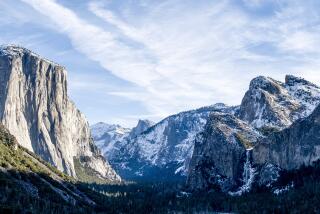Forests May Not Get Thin but Bureaucrats Will Get Fat
- Share via
George W. Bush can surely pick a backdrop. A year ago, when he unveiled his Healthy Forests Initiative, aimed at curtailing Western forest fires, his handlers arranged behind him a phalanx of Nomex-clad firefighters, not to mention a smoke plume from the 485,000-acre Biscuit Fire, the biggest blaze in Oregon history.
Last month, in Oregon again to stump for his plan, he topped even that: The original site for his planned speech on fires was ... on fire!
That allowed him to do a flyover instead -- it was quicker, and more ruggedly presidential. Upon landing in Oregon, he described the two fairly small forest fires as “a holocaust” and called them “devastating.” And he again outlined his solution: Cut down trees. OK, he calls it “thinning,” which sounds pretty benign, and he also wants to whack some of the brush and smaller “fine fuels” that have stacked up in forests after years of fire suppression. But Bush is basically borrowing a riff from Ronald Reagan, who once blamed trees for causing pollution. In this case, Bush is blaming them for causing fires.
I have met a number of people in the Forest Service, and I believe many of them are knowledgeable about fire and want to do the right thing. But in Bush’s circle of Forest Service types -- hunkered in their brick building just across the Mall from the White House -- the Healthy Forests Initiative probably has another name: the Forest Service Bureaucrat Lifetime Employment Act.
Bush’s plan would be budgetary magic for the Forest Service. In addition to each summer’s damn-the-cost orgy of firefighting (many forest fires cost $1 million a day to fight, with no limits on the checkbook), the agency would be back in the timber business: planning thinning projects, managing same, probably building or rebuilding roads to access them.
The reality is that the Forest Service “experts” did much to create the present-day problem, first by stamping out many fires that would have naturally thinned out forests and by creating the impression that fires are a problem that can be “solved.” As icing, the agency gave fires a moral dimension through its famous Smokey Bear campaign. Its message: Fires are bad. And a corollary: People cause fires.
The former notion is highly debatable; fires are a natural event, not necessarily good or bad, but simply part of any forest’s life. And though people do cause fires, lightning is the main culprit, in the West, at least.
But no matter. Bush is building on an existing foundation, trumpeting the idea that we can do something about fires and insisting they’re terrible, unnatural things.
It’s true that in some forests, such as those dominated by Ponderosa pine, it may well be possible to thin out enough excess trees and brush to allow fires to resume their natural pattern of burning through every 10 years or so, cleaning up dying trees and brush or saplings that compete for scarce water. But that’s only one of many forest types in the West.
Lodgepole pine trees, which burned so spectacularly in Yellowstone National Park in 1988, aren’t designed to survive fire. They’re designed to burn to the ground every hundred years or so, to the extent that their cones often won’t release seeds unless they feel a hot blast of flame.
Also, there are two points Bush neglects to mention. First, thinning is not conducted by forest rangers with hedge trimmers. It’s done by loggers with chainsaws, and if not performed properly can damage soil and streams as well as leave behind a carpet of flammable debris. Some studies show that in certain forest types thinning may make fires worse. Second, thinning is not a one-shot deal. That’s because the very trees and brush that are thinned immediately begin growing back, necessitating a repeat treatment every five years or so.
Now, given the Forest Service’s estimates -- 190 million acres that need thinning, maybe 2.8 million a year now getting thinned -- it will take more than 50 years to get the job done. And by then, four-fifths of what has been thinned will need thinning again. Meanwhile, fires will not have stopped. Drought, lightning, the natural state of forests -- all of that will ensure that plenty of fires still will burn.
There’s much to discuss in the realm of fire, forestry and humans. But it needs to be an honest discussion, one that takes into account the complexity of both forests and fire’s role on the landscape. Apparently, Bush simply isn’t interested in having that sort of discussion.
More to Read
Sign up for Essential California
The most important California stories and recommendations in your inbox every morning.
You may occasionally receive promotional content from the Los Angeles Times.










